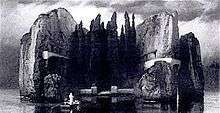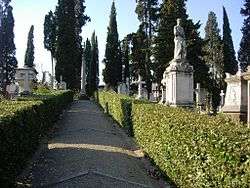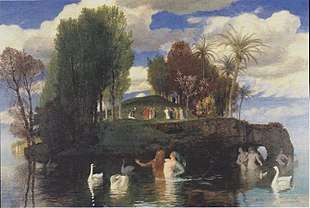Isle of the Dead (painting)
| Isle of the Dead | |
|---|---|
.jpg) Fifth version, 1886 | |
| Year | 1886 |
.jpg)
.jpg)
.jpg)

Isle of the Dead (German: Die Toteninsel) is the best-known painting of Swiss Symbolist artist Arnold Böcklin (1827–1901). Prints were very popular in central Europe in the early 20th century—Vladimir Nabokov observed in his novel Despair that they could be "found in every Berlin home".[1]
Böcklin produced several different versions of the mysterious painting between 1880 and 1886.
Description and meaning
All versions of Isle of the Dead depict a desolate and rocky islet seen across an expanse of dark water. A small rowboat is just arriving at a water gate and seawall on shore.[2] An oarsman maneuvers the boat from the stern. In the bow, facing the gate, is a standing figure clad entirely in white. Just behind the figure is a white, festooned object commonly interpreted as a coffin. The tiny islet is dominated by a dense grove of tall, dark cypress trees—associated by long-standing tradition with cemeteries and mourning—which is closely hemmed in by precipitous cliffs. Furthering the funerary theme are what appear to be sepulchral portals and windows on the rock faces.
Böcklin himself provided no public explanation as to the meaning of the painting, though he did describe it as “a dream picture: it must produce such a stillness that one would be awed by a knock on the door.”[3][4] The title, which was conferred upon it by the art dealer Fritz Gurlitt in 1883, was not specified by Böcklin, though it does derive from a phrase in an 1880 letter he sent to the painting’s original commissioner.[5] Not knowing the history of the early versions of the painting (see below), many observers have interpreted the oarsman as representing the boatman Charon who ferried souls to the underworld in Greek mythology. The water would then be either the River Styx or the River Acheron and his white-clad passenger a recently deceased soul transiting to the afterlife.
Origins and inspiration


_-_Bay_of_Kotor%2C_Montenegro_-_28_July_2010_-_(1).jpg)
Isle of the Dead evokes, in part, the English Cemetery in Florence, Italy, where the first three versions were painted. The cemetery was close to Böcklin's studio and was also where his infant daughter Maria was buried. (In all, Böcklin lost 8 of his 14 children).
The model for the rocky islet was perhaps Pontikonisi, a small, lush island near Corfu which is adorned with a small chapel amid a cypress grove,[6] perhaps in combination with the mysterious rocky island of Strombolicchio near the famous volcano Stromboli, Sicily. (Another less likely candidate is the island of Ponza in the Tyrrhenian Sea.)
Michael Webber. "London Galleries: Peace and War." Apollo 93 (June 1971), p. 510, states that it was painted in the Bay of Kotor in Montenegro, and that it inspired the composer Rachmaninoff. This claim is supported by the similarity between the painting and the island of St. George near Perast, which is lined by cypress groves and houses a church dedicated to Saint George.
Versions
Böcklin completed the first version of the painting in May 1880 for his patron Alexander Günther, but kept it himself. In April 1880, while the painting was in progress, Böcklin's Florence studio had been visited by Marie Berna, née Christ (widow of financier Dr. Georg von Berna [1836–65] and soon-to-be wife of the German politician Waldemar, Count of Oriola [1854–1910]). She was struck by the first version of this "dream image" (now in the Kunstmuseum Basel), which sat half completed on the easel, so Böcklin painted a smaller version on wood for her (now in the Metropolitan Museum in New York City). At Berna's request, he added the coffin and female figure, in allusion to her husband's death of diphtheria years earlier. Subsequently, he added these elements to the earlier painting. He called these works Die Gräberinsel ("Tomb Island").[7] (Sometimes the "Basel" version is credited as the first one, sometimes the "New York".) It was acquired by the Gottfried Keller-Stiftung in 1920.[8]
The third version was painted in 1883 for Böcklin’s dealer Fritz Gurlitt. Beginning with this version, one of the burial chambers in the rocks on the right bears Böcklin's own initials: "A.B.". (In 1933, this version was put up for sale and a noted Böcklin admirer, Adolf Hitler, acquired it. He hung it first at the Berghof in Obersalzberg and, then after 1940, in the New Reich Chancellery in Berlin. It is now at the Alte Nationalgalerie, Berlin.)
Financial imperatives resulted in a fourth version in 1884, which was ultimately acquired by the entrepreneur and art collector Baron Heinrich Thyssen and hung at his Berliner Bank subsidiary. It was burned after a bomb attack during World War II and survives only as a black-and-white photograph.
A fifth version was commissioned in 1886 by the Museum of Fine Arts, Leipzig, where it still hangs.

In 1888, Böcklin created a painting called Die Lebensinsel ("Isle of Life"). Probably intended as an antipole to the Isle of the Dead, it also shows a small island, but with all signs of joy and life. Together with the first version of the Isle of the Dead, this painting is part of the collection of the Kunstmuseum Basel.
Versions
- May 1880 – Oil on canvas; 111 x 155 cm; Öffentliche Kunstsammlung, Kunstmuseum, Basel.
- June 1880 – Oil on board; 74 x 122 cm; The Metropolitan Museum of Art, Reisinger Fund, New York.
- 1883 – Oil on board; 80 x 150 cm; Alte Nationalgalerie, Staatliche Museen zu Berlin.
- 1884 – Oil on copper; 81 x 151 cm; destroyed in Berlin during World War II.
- 1886 – Oil on board; 80 x 150 cm; Museum der bildenden Künste, Leipzig.
Works inspired by Isle of the Dead
Paintings
- Salvador Dalí's 1932 painting The Real Picture of the Isle of the Dead by Arnold Böcklin at the Hour of the Angelus is inspired by Böcklin's work.[9]
- German artist Michael Sowa has painted Böcklin 6th version, a parody of the painting.
- The Swiss artist H. R. Giger created a version of the picture, Hommage à Böcklin (1977), in his typical biomechanical style.[9]
- Fabrizio Clerici, the noted Italian Surrealist painter, paraphrased Böcklin's seminal painting in two of his works, namely Le Presenze, dating from 1974, and Latitudine Böcklin, completed in 1979.
- Italian comic artist Gipi did an everyday-life-version of the Island of the Dead.
- Australian Surrealist painter James Gleeson drew a parallel with the painting and the entrance to the underworld in the Aeneid in his 1989 work, Avernus Transvisioned as Böcklin's Isle.
Drama
Theatre
- August Strindberg's play The Ghost Sonata (1907) ends with the image of Isle of the Dead accompanied by melancholy music. It was one of Strindberg's favourite pictures.
Film
- Val Lewton used the painting in scene backgrounds for his 1943 film I Walked with a Zombie, a story about an island of the dead.[9]
- Val Lewton's later 1945 horror film Isle of the Dead was also inspired by the painting, which serves as a backdrop to the picture's title sequence.[9]
- The painting has inspired two National Film Board of Canada animated shorts.
- It is the explicit backdrop for Norman McLaren's short animated film A Little Phantasy on a 19th-century Painting (1946).
- More recently, animator Craig Welch has stated that both the painting and McLaren's film were inspirations for his 1996 short, How Wings Are Attached to the Backs of Angels.[10]
- Design elements from the painting appear in mattes[11] and sets[12] in the 1951 film The Tales of Hoffmann.[9]
- The 2012 American computer-animated horror-comedy film 'Hotel Transylvania' features several copies of the painting (possibly Third Version) on walls around Dracula's castle, including just inside the door of Mavis' bedroom.
- Alien: Covenant (2017) references the painting during a scene set in the garden[13]
Television
- Böcklin's painting was used in season 5 episode 3 of Pretty Little Liars ("Surfing the Aftershocks"), mysteriously affecting one of the main characters.
- In the manga and anime series Kuroshitsuji, is shown a place called "Island of Death", described as a sanctuary for demons and it is also the designated area to commence a formal duel between individuals of the said race.
Literature
- In J.G. Ballard's 1966 novel The Crystal World, Böcklin's second version of the painting is invoked to describe the gloom of the opening scene at Port Matarre.
- Roger Zelazny used the picture as an inspiration for the meeting place of two mythological antagonists in his novel Isle of the Dead (1969).[9]
- Bernard Cornwell's The Warlord Chronicles (1995–97) associates Dorset's Isle of Portland with the painting's isle. It is described as a place of internal exile and damnation. The causeway that almost links the real-life island to the mainland was supposed to be guarded to keep the dead (including the criminally insane) from crossing the Fleet and escaping back into Britain.
- Graphic novel Ile des morts (text: Thomas Mosdi, drawings: Guillaume Sorel) has the pictures playing a key role in its gothic, Lovecraftian story.
Music
- The Island of the Dead (1890) is a symphonic poem by Romantic composer Heinrich Schülz-Beuthen evoking the painting.
- Andreas Hallén, a Swedish Romantic composer, wrote a symphonic poem "Die Toteninsel" in 1898.
- Dezso d’Antalffy, a Hungarian Romantic composer, wrote a symphonic poem "Die Toteninsel" in 1907.
- Sergei Rachmaninoff also composed a symphonic poem, Isle of the Dead, Op. 29 (1909), inspired by a black-and-white print of the painting. He said that had he seen the colour original, he probably would not have written the music.
- Felix Woyrsch composed 3 Böcklin Phantasies (Die Toteninsel, Der Eremit, Im Spiel der Wellen), Op. 53 (1910)
- One of the four tone poems of German composer Max Reger’s Vier Tondichtungen nach A. Böcklin (Op 128, 1913) is “Die Totensel” (No. 3), based on the painting. (The same year, Reger’s disciple Fritz Lubrich, Junior [1888–1971] composed Drei Romantische Tonstücke nach Böcklinschen Bildern (Three Romantic Tonstücke after Böcklin’s Pictures; Op 37), an organ work of which No. 3 is also The Dead Island.)
- The Swedish neoclassical band Arcana used an image of Isle of the Dead on the cover of their debut album Dark Age of Reason (1996).
- An album by Harald Blüchel was named after the painting- Die Toteninsel (Zauberberg-Trilogie Teil 1) (2006). The third version of the painting is shown on the cover of this album.
- Visit on the Island of the Dead (2009-2010)[14] is a symphonic poem for orchestra, composed by the Norwegian composer Kristian Oma Rønnes.
- The heavy metal band Atlantean Kodex used Die Toteninsel (Version III) as a cover for their first full-length album, The Golden Bough (October 2010).
- American songwriter and singer Rykarda Parasol wrote her song "Island of the Dead (Oh Mi, Oh My)" for the Amsterdam Van Gogh Museum's exhibition Dreams of nature (2012), where the fifth version of the painting was on show. The song, together with Rachmaninoff's piece, was possible to listen to while watching the painting.[15] The song is on Parasol's 2013 album Against the Sun.[16]
References
- ↑ Nabokov, Vladimir (1936; English translations 1937, 1965), Despair, p. 56.
- ↑ That the boaters are arriving at, and not departing from, the island is an assumption. The oarsman is positioned to row away from the shore, but in some versions the ripples of the boat’s wake suggest that they are moving forward. Hubert, Locher (2004), "Arnold Böcklin: Die Toteninsel. Traumbild des 19. Jahrhunderts"; In: Kunsthistorische Arbeitsblätter [Translation: "Arnold Böcklin: The Isle of the Dead; Dream Image of the 19th Century"; In: Art History Worksheets], Zeitschrift für Studium und Hochschulkontakt; Issue 7/8, p. 71.
- ↑ Culshaw, John (1949), Rachmaninov: The Man and his Music, p. 73.
- ↑ To Marie Berna he wrote on 29 June 1880: "Am letzten Mittwoch ist das Bild "Die Gräberinsel“ an sie abgegangen. Sie werden sich hineinträumen können in die Welt der Schatten, bis sie den leisen lauen Hauch zu fühlen glauben, den das Meer kräuselt. Bis sie Scheu haben werden die feierliche Stille durch ein lautes Wort zu stören."
- ↑ Upon completing Alexander Günther’s version, Böcklin sent him a letter saying that "... finally with the Toteninsel finished I think it will make quite the impression” (“...Endlich ist die Toteninsel soweit fertig, dass ich glaube, sie werde einigermaßen den Eindruck machen...“)
- ↑ Harrison, Max (2005), Rachmaninoff, Continuum International Publishing Group, p. 159.
- ↑ The artist apparently used this title for the rest his life, as indicated by a congratulatory telegram on the occasion of the Count's 70th birthday (1897) in which the artist refers to "...die glücklichen Besitzer der Gräberinsel..." ("... the lucky owner of ‘Tomb Island’...").
- ↑ "Gottfried Keller-Stiftung: Ausleihe und Reproduktionen" (in German). bundesmuseen.ch. Retrieved 2014-12-05.
- 1 2 3 4 5 6 John Coulthart (28 October 2011). "A Picture to Dream Over: The Isle of the Dead". Tor.com. Retrieved 25 July 2016.
- ↑ Jayne Pilling, ed. (29 May 2012). "On Craig Welch's How Wings Are Attached to the Backs of Angels". Animating the Unconscious: Desire, Sexuality, and Animation. Wallflower Press. ISBN 978-0231161992. Retrieved 17 July 2012.
- ↑ The Tales of Hoffman matte
- ↑ The Tales of Hoffman set
- ↑ Wayne Haag (23 May 2017). "Alien Covenant - Cathedral". Retrieved 24 May 2017.
- ↑ List of Compositions at kristianomaronnes.com Archived 2016-01-13 at the Wayback Machine.
- ↑ "Van Gogh Museum Annual Report 2012". Retrieved 27 December 2016.
- ↑ Parasol, Rykarda. "Against the Sun".